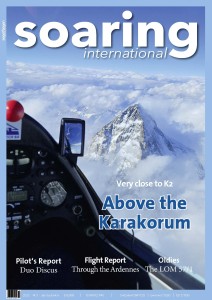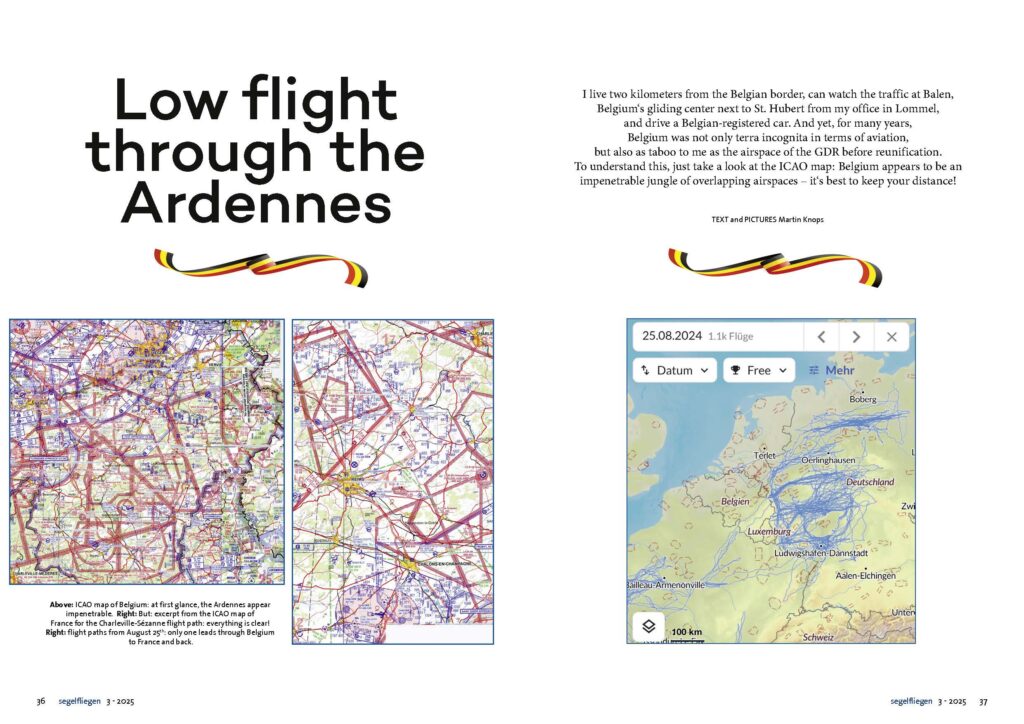
segelfliegen magazine issue 03-2025 is here!
Once again, a wealth of interesting and informative articles await you: After a review of AERO 25, we accompany Sebastian Kawa on his adventurous journey to Pakistan, where he flew over K2. An expedition like this requires a huge amount of preparation – but even a “normal” cross-country flight in southern Germany is no walk in the park. So what goes into a 2,011 km flight? Of course, you can’t do without thermals, which is why our meteorologist explains why you can find great thermals under cumulus clouds. We’ll tell you how to find the right path when flying low over the Ardennes and why the final approach has to be spot on in the gliding paradise of Namibia. In the Pilot’s Report, we take a closer look at the Duo Discus. We continue with the SPOSOS, who report on their first three months, and young glider pilots who spent an exciting week at the Fayence gliding camp. The accident involving a young pilot in a Swift shows how important it is never to overestimate your abilities. For our vintage aircraft fans, we have been following the restoration of the LOM 57/1, and for clubs, we have a few tips on how to foster a positive club culture. To ensure that winch launches go smoothly, we explain the wing area and rope weight required for approach, while for F-towing, turning is an important maneuver. Finally, we look back to 1894, when the first two gliding clubs were founded.
Don’t want to miss out on anything? Click here to subscribe!
And you can read a little preview now:

I live two kilometers from the Belgian border, can watch the traffic at Balen, Belgium‘s gliding center next to St. Hubert from my office in Lommel, and drive a Belgian-registered car. And yet, for many years, Belgium was not only terra incognita in terms of aviation, but also as taboo to me as the airspace of the GDR before reunification. To understand this, just take a look at the ICAO map: Belgium appears to be an impenetrable jungle of overlapping airspaces – it‘s best to keep your distance!
My ambition to change this was sparked by several flights by Hermann Leucker, who fearlessly entered Belgian airspace from Leverkusen, crossed the Ardennes, and returned safely! So it had to be possible somehow! I spent the next long winter evenings searching the internet for information. Here are two links that will help you quickly find your way through the jungle:
- The homepage of the Flemish Gliding Association. Here, under the tab “luchtruim,” you will find the “VFR Guide” in English and finally the “LFA Golf Status”: www.lvzc.be
- www.notam.info
Summary: It is not recommended to fly through Belgium during the week. The airspace above 4,500’ is reserved for military use. Below 4,500’, the airspace is generally uncontrolled and therefore open to gliders, but there are a number of restricted areas whose status must be checked before flying in, for example via notam.info.
The situation is completely different at the weekend. Outside the vicinity of the few large airports (and with the exception of a few restricted areas), the entire airspace up to flight level 55 or higher (often FL75) is uncontrolled and free! All the necessary information can be found on the gliding association‘s website in a compact and easy-to-understand format. It‘s just like always: once you know how it works, it‘s really simple. And so, when the weather conditions have been right, I have flown through Belgian airspace quite often in recent years. This was also the case on August 25, 2024.
Topmeteo had been forecasting perfect weather for days. At first, I didn‘t want to believe the “hole” that was predicted for the Bergisches Land region in the morning. Why? And how can you predict something so local three days in advance? But it was true! So, I made a quick decision at the start and instead of flying east as originally planned (which worked out wonderfully a little later in the day), I flew southwest towards Belgium. This made sense anyway given the extremely low base at the start (2,000’ / 600 m MSL). Destination: Sézanne Airfield, in the middle of France, east of Paris and a good 30 miles / 50 km southwest of Reims.
Airspace in France
So I would also have to deal with French airspace. This puts many German glider pilots off in much the same way as Belgian airspace. However, on closer inspection and with a little preparation, many of these concerns disappear…..
What happens next? Read the full article in our 03-2025 issue.

